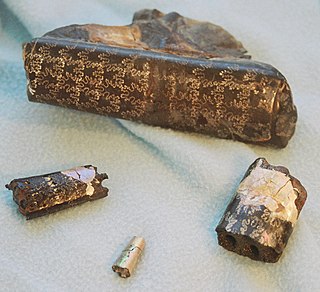
Ammonoids are a group of extinct marine mollusc animals in the subclass Ammonoidea of the class Cephalopoda. These molluscs, commonly referred to as ammonites, are more closely related to living coleoids than they are to shelled nautiloids such as the living Nautilus species. The earliest ammonites appeared during the Devonian, with the last species vanishing during or soon after the Cretaceous–Paleogene extinction event.

Baculites is an extinct genus of heteromorph ammonite cephalopods with almost straight shells. The genus, which lived worldwide throughout most of the Late Cretaceous, and which briefly survived the K-Pg mass extinction event, was named by Lamarck in 1799.
Agathiceras is a subglobose goniatitid from the family Agathiceratidae, widespread and locally abundant in Lower Pennsylvanian to Middle Permian sediments, e.g. the Urals, Sicily, and Texas.
Beyrichoceras is a genus belonging to the goniatitid family Muensteroceratidae, a group of ammonoids, extinct shelled cephalopods related to belemnites and recent coleoids and more distantly to the nautiloids
Cheiloceratidae is a family of ammonoid cephalopods included in the goniatitid suborder Tornoceratina in which the suture has 4 to 12 lobes, the ventral one undivided and those in the lateral areas originating as subdivisions of internal and external lateral saddles.
Tornoceratoidea, also known as Tornocerataceae, is a superfamily of goniatitid ammonoids included in the suborder Tornoceratina. Tornoceratoidea, or Tornocerataceae, is essentially the Cheilocerataceae of Miller, Furnish, and Schindewolf (1957) in the Treatise Part L, revised to accommodate new taxa and new perspectives on the phylogeny.
Adrianitidae is a family in the Adrianitaceae, a superfamily of ammonites in the cephalopod order, Goniatitida, known from the Middle Pennsylvanian to the Middle Permian.

Discoscaphites is an extinct genus of ammonite. This genus may have been one of the few to have briefly survived the K-Pg mass extinction.

Hoploscaphites is an extinct ammonite genus from the Upper Cretaceous and the Lower Paleocene, included in the family Scaphitidae.

Prolecanitida is an order of extinct ammonoid cephalopods, the major Late Paleozoic group of ammonoids alongside the order Goniatitida. Prolecanitids had narrow shells, discoidal (disc-shaped) to thinly lenticular (lens-shaped). They retained a retrochoanitic siphuncle, a simple form with septal necks extending backwards. As is typical for ammonoids, the siphuncle sits along the ventral margin of the shell.

Clymeniida is an order of ammonoid cephalopods from the Upper Devonian characterized by having an unusual dorsal siphuncle. They measured about 4 cm (1.6 in) in diameter and are most common in Europe, North Africa, and South China but are known from North America and Australia as well.
Nelomites is genus of ammonoid cephalopods belonging to the Cheiloceratidae family. Species belonging to this genus lived in late Devonian (Famennian). This genus was originally described under the name MelonitesBogoslovskii, 1971; however, the same generic name has also been used for genus of echinoid named MelonitesNorwood & Owen, 1846. Bockwinkel, Korn & Herd (2019) coined a replacement generic name Nelomites.
Acanthoclymenia is genus of ammonoid cephalopods belonging to the Acanthoclymeniidae family. Species belonging to this genus lived in middle and late Devonian. Its fossils were found in Europe, Asia, north Africa, North America and Australia. Species of this genus had discoidal shells with flattened venter.
This list, 2017 in paleomalacology, is a list of new taxa of ammonites and other fossil cephalopods, as well as fossil gastropods, bivalves and other molluscs that are scheduled to be described during the year 2017, as well as other significant discoveries and events related to molluscan paleontology that are scheduled to occur in the year 2017.
This list 2019 in paleomalacology is a list of new taxa of ammonites and other fossil cephalopods, as well as fossil gastropods, bivalves and other molluscs that are scheduled to be described during the year 2019, as well as other significant discoveries and events related to molluscan paleontology that are scheduled to occur in the year 2019.
This list 2020 in paleomalacology is a list of new taxa of ammonites and other fossil cephalopods, as well as fossil gastropods, bivalves and other molluscs that are scheduled to be described during the year 2020, as well as other significant discoveries and events related to molluscan paleontology that are scheduled to occur in the year 2020.

The term Paleocene ammonites describes families or genera of Ammonoidea that may have survived the Cretaceous–Paleogene extinction event, which occurred 66.043 million years ago. Although almost all evidence indicated that ammonites did not survive past the K–Pg boundary, there is some scattered evidence that some ammonites lived for a short period of time during the Paleocene epoch, although none survived the Danian ; they were likely extinct within 500,000 years of the K-Pg extinction event, which correlates to roughly 65.5 Ma. The evidence for Paleocene ammonoids is rare and remains controversial.
Patelloctopodidae is a family of stem-octopod cephalopods from the Middle and Late Jurassic of Europe. Five genera are currently placed in the family, Etchesia, Muenstellerina,Patelloctopus,Pearciteuthis and Tyrionella, Patelloctopodidae is one of two families in the superfamily Muensterelloidea along with the Muensterellidae. They are thought to be the group from which modern octopus arose.

Eubaculites is an extinct genus of cephalopods in the family Baculitidae and each known species was initially placed within the related genus Baculites until it was placed in a separate genus in 1926.

The Rødvig Formation is a geological formation deposited during the earliest part of the Danian and it was first identified by Richard Taylor and Richard Phillips in 1827. It is known from exposures at Stevns Klint in Denmark. The unit lies directly above the K–Pg boundary and contains fossils that provide a record of the recovery of various groups following the Cretaceous–Paleogene extinction. The upper boundary of the formation is an unconformity in the form of a hardground, beneath which the formation is sometimes missing. The base of the unit is irregular due to the presence of mounding associated with bryozoa, causing variations in thickness. The unit is subdivided into the lower Fiskeler Member mainly formed of marl and the overlying Cerithium Limestone Member.







